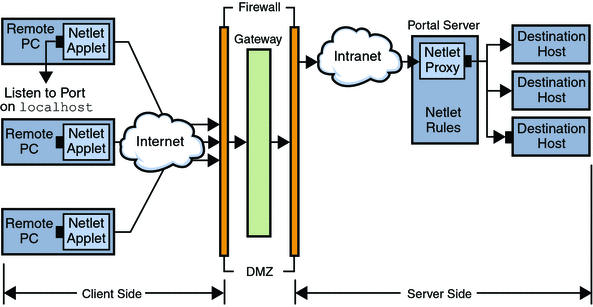Introduction to Netlet
Sun Java System Portal Server software users may want to run popular or company-specific applications on their remote desktops in a secure manner. You can provide secure access to these applications by setting up Netlet on your platform.
Netlet enables users to securely run common TCP/IP services over insecure networks such as the Internet. You can run TCP/IP applications (such as Telnet and SMTP), HTTP applications, and any fixed port applications.
If an application is TCP/IP-based or it uses fixed ports, you can run the application over Netlet.
Note –
Dynamic ports are supported only when FTP is used. To use Microsoft Exchange, use OWA (Outlook Web Access).
Ensure that you notify the users to disable the pop-up blockers options in their browser, when using Netlet.
Netlet Components
The various components used by Netlet are shown in Netlet Components.
Figure 6–1 Netlet Components

Listen Port on localhost
This is the port on the client machine on which the Netlet applet listens. The client machine is the localhost.
Netlet Applet
The Netlet applet is responsible for setting up an encrypted TCP/IP tunnel between the remote client machine and intranet applications such as Telnet, Graphon or Citrix. The applet encrypts the packets and sends them to the Gateway, and decrypts the response packets from the Gateway and sends them to the local application.
For static rules the Netlet applet is downloaded automatically when the user logs into the portal. For dynamic rules, the applet is downloaded when the user clicks on the link corresponding to the dynamic rule. See Types of Rules for details on static and dynamic rules.
To run Netlet in a Sun Ray Environment, see Running Netlet in a Sun Ray Environment.
Netlet Rules
A Netlet rule maps an application that needs to run on a client machine to the corresponding destination host. This means that Netlet operates only on packets sent to ports defined in the Netlet rule. This ensures greater security.
As an administrator, you need to configure certain rules for the functioning of Netlet. These rules specify various details such as the cipher to be used, URL to invoke, the applets to be downloaded, the destination port and the destination host. When a user on a client machine makes a request through Netlet, these rules help determine how the connection must be established. See Defining Netlet Rules for details.
Netlet Provider
This is the UI component of Netlet. The provider allows users to configure the required applications from the Portal Server desktop. A link is created in the provider, and the user clicks on this to run the required application. Users can also specify the destination host for a dynamic rule in the desktop Netlet provider. See Defining Netlet Rules.
Netlet Proxy (Optional)
The Gateway ensures a secure tunnel between the remote client machine and the Gateway. The Netlet proxy is optional and you may choose not to install this proxy during the installation. For information on the Netlet proxy, see Using a Netlet Proxy.
Netlet Usage Scenario
The following sequence of events are involved in using Netlet:
-
The remote user logs into the Portal Server desktop.
-
If a static Netlet rule has been defined for a user, role or organization, the Netlet applet is automatically downloaded to the remote client.
If a dynamic rule has been defined for a user, role, or organization, the user needs to configure the required application in the Netlet provider. The Netlet applet is downloaded when the user clicks on the application link in the Netlet provider. See Defining Netlet Rules for details on static and dynamic rules.
-
Netlet listens on the local ports defined in the Netlet rules.
-
Netlet sets up a channel between the remote client and host over the ports specified in the Netlet rule.
Working With Netlet
For Netlet to work as required for various users across different organizations, you need to do the following:
-
Determine whether you need to create static or dynamic rules based on the user requirements. See Types of Rules.
-
Configure the options for the Netlet service from the Portal Server administration console. For information on configuring Netlet, see Chapter 11, Configuring the Netlet.
-
Determine whether the rules should be organization, role, or user based and make modifications as required at each level. See the Portal Server Administration Guide for details on organization, role and user.
Note –Do not localize the value for the frameset parameter in the srapNetletServlet.properties file.
- © 2010, Oracle Corporation and/or its affiliates
